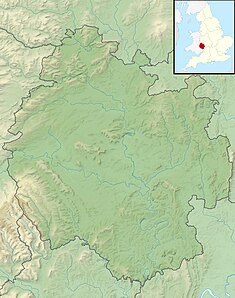Perrycroft
| Perrycroft | |
|---|---|
 "One of Vosey's best"[1] | |
| Type | Country house |
| Location | Colwall, Herefordshire |
| Coordinates | 52°04′27″N 2°20′37″W / 52.0741°N 2.3437°W |
| Built | 1893-1895 |
| Architect | C. F. A. Voysey |
| Architectural style(s) | Arts & Crafts |
| Governing body | Privately owned |
Listed Building – Grade II* | |
| Official name | Perrycroft |
| Designated | 18 February 1970 |
| Reference no. | 1178660 |
Listed Building – Grade II* | |
| Official name | Summerhouse, gate, boundary walls south west of Perrycroft |
| Designated | 19 September 1984 |
| Reference no. | 1349715 |
Listed Building – Grade II | |
| Official name | Perrycroft Lodge |
| Designated | 18 February 1970 |
| Reference no. | 1082156 |
Listed Building – Grade II | |
| Official name | Coachhouse, cottage and tack-room west of Perrycroft Lodge |
| Designated | 18 February 1970 |
| Reference no. | 1178672 |
Listed Building – Grade II | |
| Official name | Stables About 75 Yards Northwest of Perrycroft Lodge |
| Designated | 18 February 1970 |
| Reference no. | 1178680 |
Perrycroft is a country house in the district of Colwall, Herefordshire, England. The house was built between 1893-1895 and was designed by C. F. A. Voysey for John William Wilson. Perrycroft is a Grade II* listed building.
History
[edit]John William Wilson, PC, JP (22 October 1858 – 18 June 1932) was a British chemical manufacturer and politician who served for 27 years as a Liberal member of parliament (MP) for North Worcestershire.[2] His father, John Edward Wilson, had founded the chemical manufacturers, Albright and Wilson, in 1856, in partnership with his fellow Quaker, Arthur Albright.[3] The firm specialised in phosphorus production, principally for the making of matches and became extremely successful. John William Wilson followed his father onto the board of Albright and Wilson, and also held directorships with other major concerns, including Bryant & May and the Great Western Railway.[a][2]
Wilson knew the area of the Malvern Hills through family connections, and it was proximate to the Oldbury site of the Albright and Wilson works. In 1893 he bought 80 acres of land around Colwall and commissioned Charles Vosey to design a country house. Pevsner records the price as £4,900.[4] Perrycroft was Vosey's first major commission and did much to establish his reputation.[b][6]
Perrycroft remains privately owned but the gardens and house are occasionally opened for visitors.[7][8]
Architecture and description
[edit]The house is designed in Vosey's trademark Arts and Crafts style.[6] The hipped roofs are of green/grey slate, with sweeping eaves, and five monumental chimney stacks.[1] The bell bracket on the "pagoda-like"[1] tower at the entrance front displays another typical Vosey feature; the bracket is a stylised human face or grotesque, a device he often deployed.[9] Historic England considers it "one of Vosey's best houses".[1] Vosey's 21st century biography, David Cole, in his study, The Art of CFA Voysey, describes it as "the very essence of a 'Vosey house', not only in its catalogue of Vosey details and palette of materials, but also in its form and .... composition".[10] Perrycroft is a Grade II* listed building.[1] Other listed structures on the estate include a summer house, [11] a lodge,[12] a coach house,[13] and two sets of stables.[14][15]
Gallery
[edit]-
Illustration of Perrycroft from Modern Homes, 1909
-
Illustration of Perrycroft from Modern Homes, 1909
Notes
[edit]- ^ Historic England, among others, describes John William Wilson as a "railway magnate", although his fortune derived from the family chemical works.[2]
- ^ Vosey became a favoured architect of the English upper-middle classes, designing houses for businessmen, politicians and artists. The First World War virtually destroyed his architectural practice, and his last decades saw him largely focused on furniture and fabric design.[5]
References
[edit]- ^ a b c d e Historic England. "Perrycroft (Grade II*) (1178660)". National Heritage List for England. Retrieved 4 August 2024.
- ^ a b c "Perrycroft - An Arts and Crafts House in Malvern". Perrycroft Estate. Retrieved 4 August 2024.
- ^ Gilmour 2013, p. 5.
- ^ Brooks & Pevsner 2012, p. ?.
- ^ "Great British Architects: C.F.A Voysey (1857-1941)". Country Life. 16 May 2010. Retrieved 4 August 2024.
- ^ a b Dunnett, James (24 August 2015). "CFA Voysey (1857-1941)". Architectural Review. Retrieved 4 August 2024.
- ^ "Visiting Perrycroft". Perrycroft Estate. Retrieved Aug 4, 2024.
- ^ "Perrycroft - Malvern". National Garden Society. 22 Mar 2024. Retrieved 4 August 2024.
- ^ "Profiles by Voysey". Voysey Society. Retrieved 4 August 2024.
- ^ Cole 2015, p. 40.
- ^ Historic England. "Summerhouse, gate, boundary walls About 60 yards south west of Perrycroft with associated walls (Grade II*) (1349715)". National Heritage List for England. Retrieved 4 August 2024.
- ^ Historic England. "Perrycroft Lodge (Grade II) (1082156)". National Heritage List for England. Retrieved 4 August 2024.
- ^ Historic England. "Coach house, cottage and tack-room about 30 yards west of Perrycroft Lodge (Grade II) (1178672)". National Heritage List for England. Retrieved 4 August 2024.
- ^ Historic England. "Stables about 75 yards northwest of Perrycroft Lodge (Grade II) (1178680)". National Heritage List for England. Retrieved 4 August 2024.
- ^ Historic England. "Stables about 70 yards west of Perrycroft Lodge (Grade II) (1082157)". National Heritage List for England. Retrieved 4 August 2024.
Sources
[edit]- Brooks, Alan; Pevsner, Nikolaus (2012). Herefordshire. The Buildings of England. New Haven, US and London: Yale University Press. ISBN 978-0-300-12575-7. OCLC 759174126.
- Cole, David (2015). The Art of CFA Voysey: English Pioneer Modernist Architect and Designer. Images Publishing. ISBN 9781864706048.
- Gilmour, Rodney (2013). Phosphoric Acid: Purification, Uses, Technology, and Economics. Boca Raton, FL: CRC Press. ISBN 978-1-4398-9516-0.



